Dissertation: Self-Checkout System & Customer Satisfaction at Tesco
VerifiedAdded on 2023/03/29
|46
|13208
|425
Thesis and Dissertation
AI Summary
This dissertation examines the impact of self-checkout systems (SCS) on customer satisfaction and cost reduction within the retail market, using Tesco as a case study. The research employs a mixed-methods approach, including an online survey of 120 supermarket shoppers and semi-structured interviews with Tesco managers. The study investigates the effectiveness of SCS in improving customer service and reducing costs, considering factors like speed of service, convenience, and customer preferences across different age groups. The findings suggest that SCS offers advantages for supermarkets, leading to increased revenues and enhanced customer satisfaction, especially among younger demographics. The research also highlights management's view of SCS as a long-term investment. The dissertation also reviews relevant literature and concludes with recommendations for further research and implementation strategies.
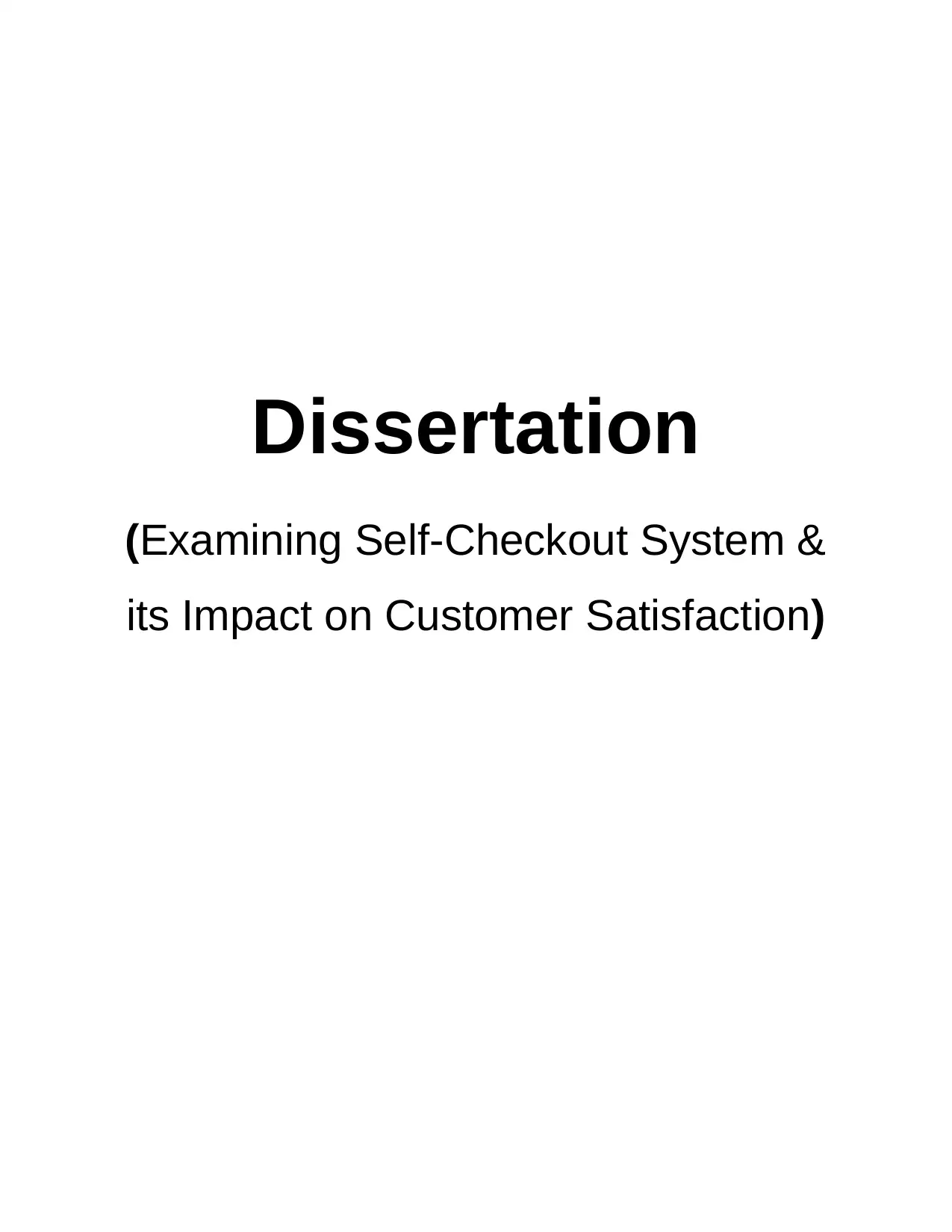
Dissertation
(Examining Self-Checkout System &
its Impact on Customer Satisfaction)
(Examining Self-Checkout System &
its Impact on Customer Satisfaction)
Paraphrase This Document
Need a fresh take? Get an instant paraphrase of this document with our AI Paraphraser
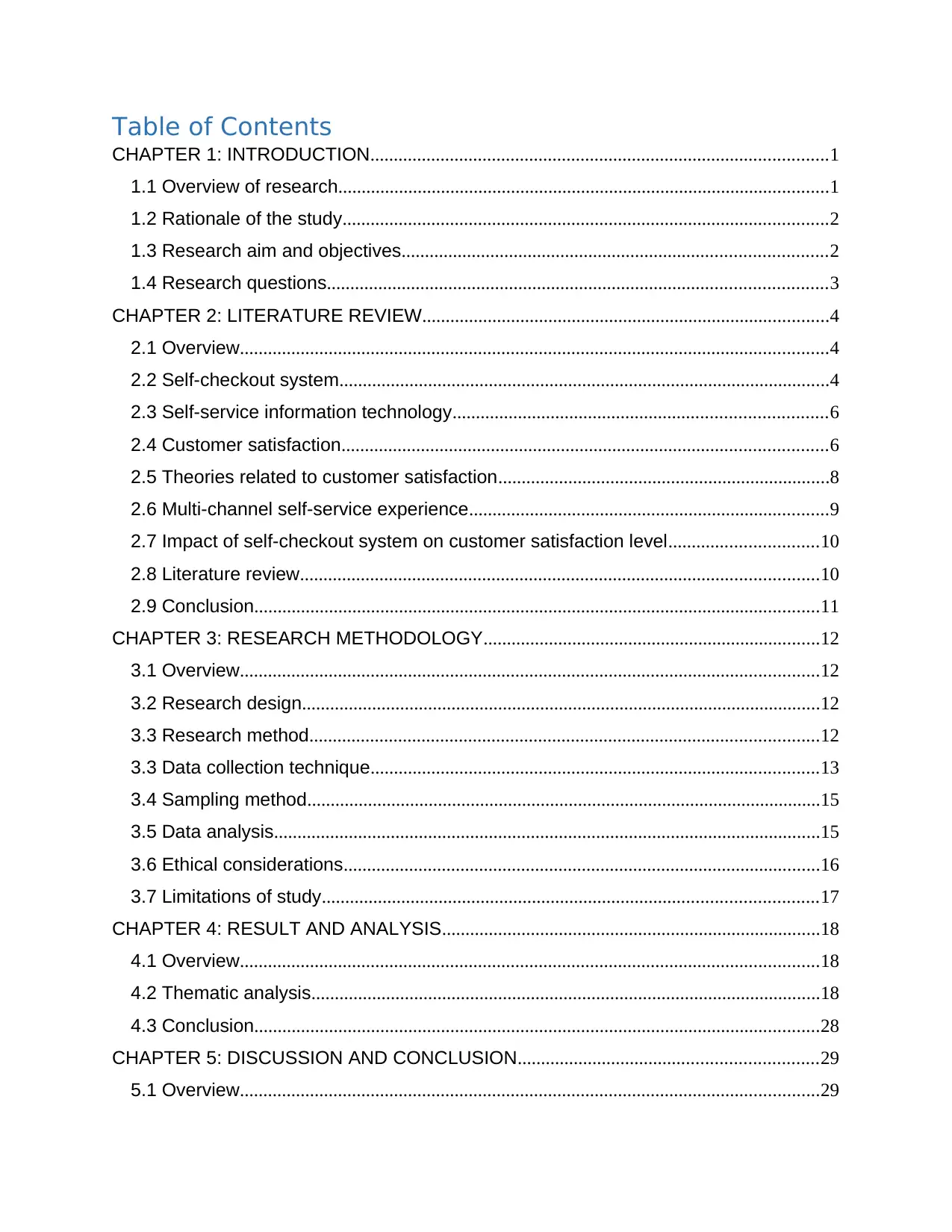
Table of Contents
CHAPTER 1: INTRODUCTION..................................................................................................1
1.1 Overview of research.........................................................................................................1
1.2 Rationale of the study........................................................................................................2
1.3 Research aim and objectives...........................................................................................2
1.4 Research questions...........................................................................................................3
CHAPTER 2: LITERATURE REVIEW.......................................................................................4
2.1 Overview..............................................................................................................................4
2.2 Self-checkout system.........................................................................................................4
2.3 Self-service information technology................................................................................6
2.4 Customer satisfaction........................................................................................................6
2.5 Theories related to customer satisfaction.......................................................................8
2.6 Multi-channel self-service experience.............................................................................9
2.7 Impact of self-checkout system on customer satisfaction level................................10
2.8 Literature review...............................................................................................................10
2.9 Conclusion.........................................................................................................................11
CHAPTER 3: RESEARCH METHODOLOGY........................................................................12
3.1 Overview............................................................................................................................12
3.2 Research design...............................................................................................................12
3.3 Research method.............................................................................................................12
3.3 Data collection technique................................................................................................13
3.4 Sampling method..............................................................................................................15
3.5 Data analysis.....................................................................................................................15
3.6 Ethical considerations......................................................................................................16
3.7 Limitations of study..........................................................................................................17
CHAPTER 4: RESULT AND ANALYSIS.................................................................................18
4.1 Overview............................................................................................................................18
4.2 Thematic analysis.............................................................................................................18
4.3 Conclusion.........................................................................................................................28
CHAPTER 5: DISCUSSION AND CONCLUSION................................................................29
5.1 Overview............................................................................................................................29
CHAPTER 1: INTRODUCTION..................................................................................................1
1.1 Overview of research.........................................................................................................1
1.2 Rationale of the study........................................................................................................2
1.3 Research aim and objectives...........................................................................................2
1.4 Research questions...........................................................................................................3
CHAPTER 2: LITERATURE REVIEW.......................................................................................4
2.1 Overview..............................................................................................................................4
2.2 Self-checkout system.........................................................................................................4
2.3 Self-service information technology................................................................................6
2.4 Customer satisfaction........................................................................................................6
2.5 Theories related to customer satisfaction.......................................................................8
2.6 Multi-channel self-service experience.............................................................................9
2.7 Impact of self-checkout system on customer satisfaction level................................10
2.8 Literature review...............................................................................................................10
2.9 Conclusion.........................................................................................................................11
CHAPTER 3: RESEARCH METHODOLOGY........................................................................12
3.1 Overview............................................................................................................................12
3.2 Research design...............................................................................................................12
3.3 Research method.............................................................................................................12
3.3 Data collection technique................................................................................................13
3.4 Sampling method..............................................................................................................15
3.5 Data analysis.....................................................................................................................15
3.6 Ethical considerations......................................................................................................16
3.7 Limitations of study..........................................................................................................17
CHAPTER 4: RESULT AND ANALYSIS.................................................................................18
4.1 Overview............................................................................................................................18
4.2 Thematic analysis.............................................................................................................18
4.3 Conclusion.........................................................................................................................28
CHAPTER 5: DISCUSSION AND CONCLUSION................................................................29
5.1 Overview............................................................................................................................29
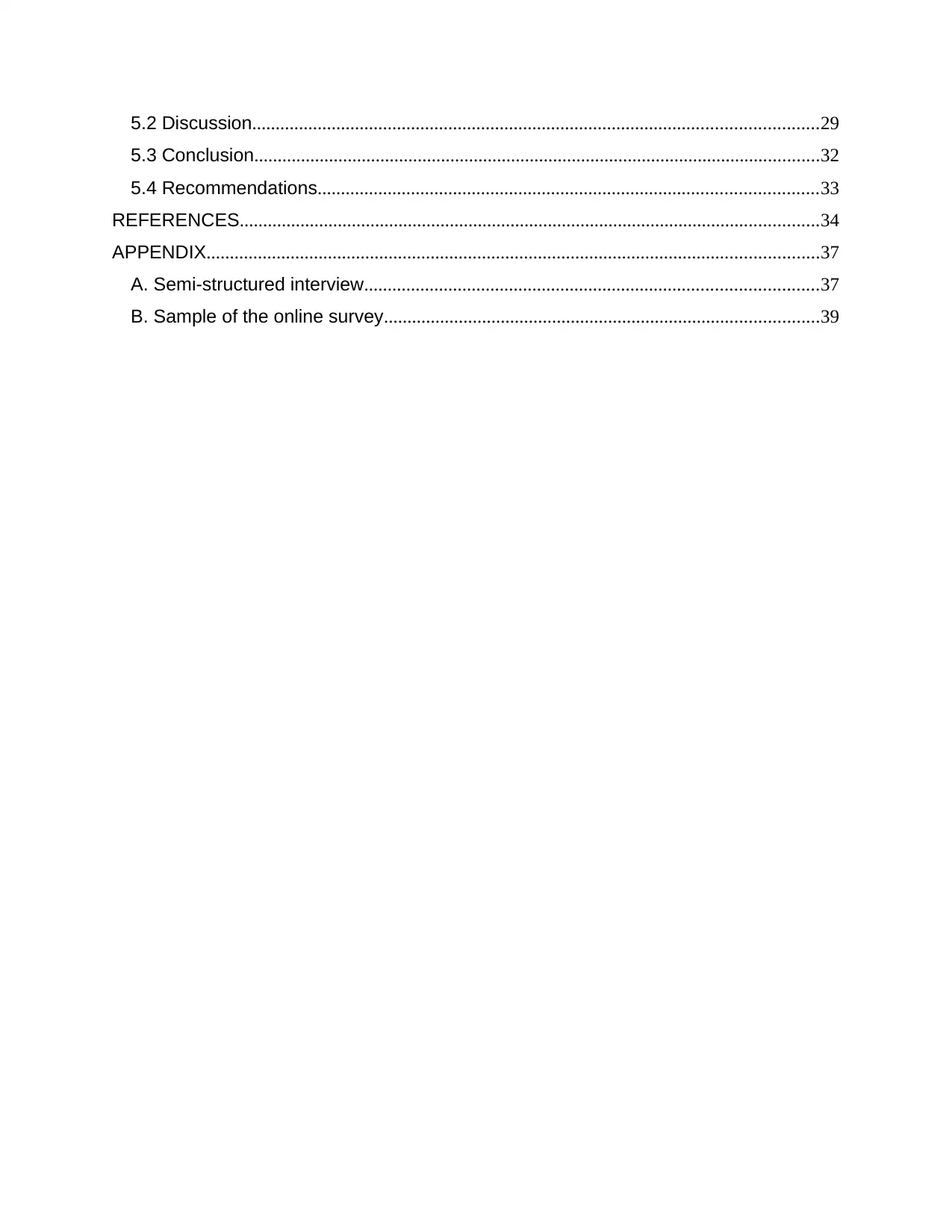
5.2 Discussion.........................................................................................................................29
5.3 Conclusion.........................................................................................................................32
5.4 Recommendations...........................................................................................................33
REFERENCES............................................................................................................................34
APPENDIX...................................................................................................................................37
A. Semi-structured interview.................................................................................................37
B. Sample of the online survey.............................................................................................39
5.3 Conclusion.........................................................................................................................32
5.4 Recommendations...........................................................................................................33
REFERENCES............................................................................................................................34
APPENDIX...................................................................................................................................37
A. Semi-structured interview.................................................................................................37
B. Sample of the online survey.............................................................................................39
⊘ This is a preview!⊘
Do you want full access?
Subscribe today to unlock all pages.

Trusted by 1+ million students worldwide

ACKNOWLEDGEMENTS
I would like to express my gratitude to my parents who have supported me all the
way and have always offered encouragement throughout my educational years. I would
also like to thank my supervisor, Yuan Huang, for her assistance and finally my younger
sister Augustina and all the participants who took part in my research.
I would like to express my gratitude to my parents who have supported me all the
way and have always offered encouragement throughout my educational years. I would
also like to thank my supervisor, Yuan Huang, for her assistance and finally my younger
sister Augustina and all the participants who took part in my research.
Paraphrase This Document
Need a fresh take? Get an instant paraphrase of this document with our AI Paraphraser
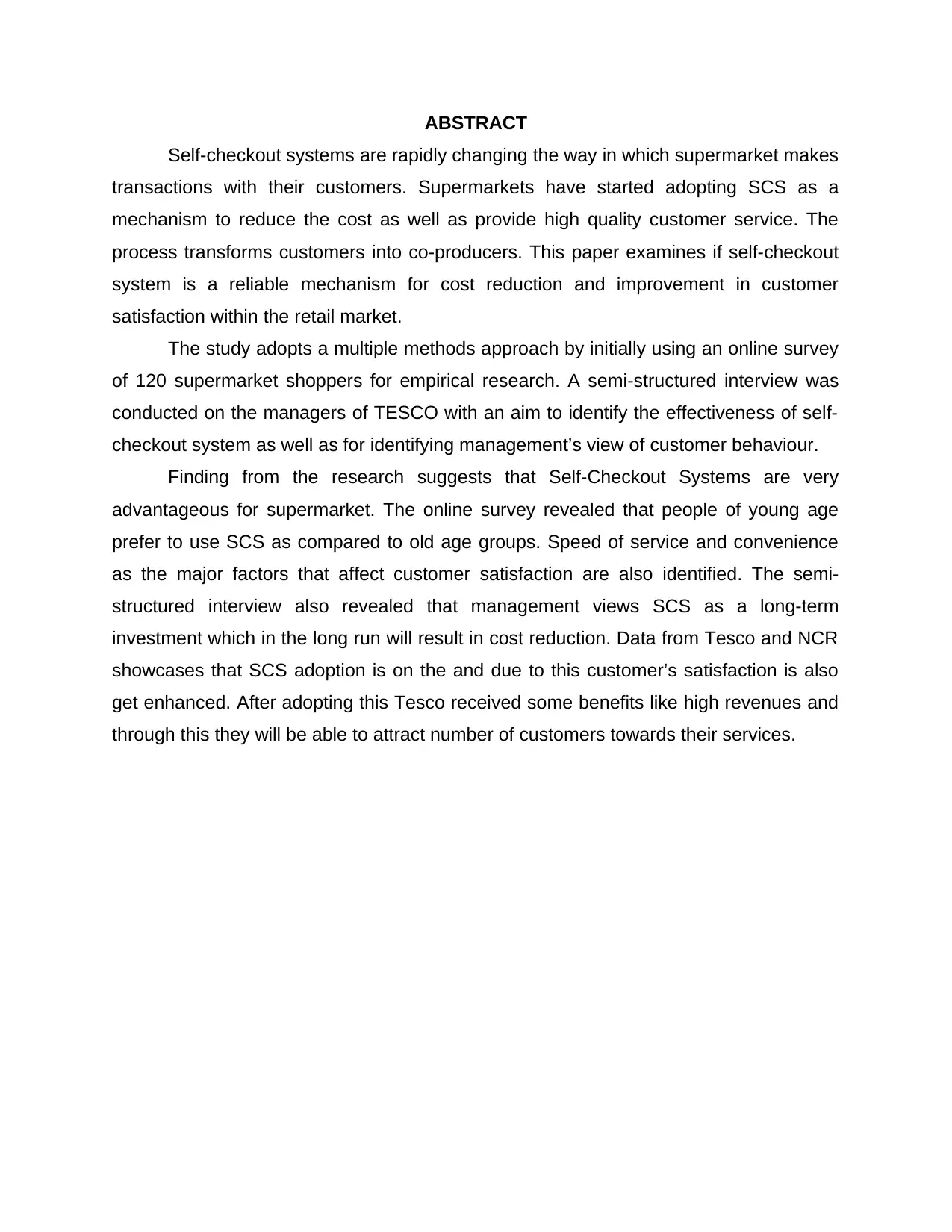
ABSTRACT
Self-checkout systems are rapidly changing the way in which supermarket makes
transactions with their customers. Supermarkets have started adopting SCS as a
mechanism to reduce the cost as well as provide high quality customer service. The
process transforms customers into co-producers. This paper examines if self-checkout
system is a reliable mechanism for cost reduction and improvement in customer
satisfaction within the retail market.
The study adopts a multiple methods approach by initially using an online survey
of 120 supermarket shoppers for empirical research. A semi-structured interview was
conducted on the managers of TESCO with an aim to identify the effectiveness of self-
checkout system as well as for identifying management’s view of customer behaviour.
Finding from the research suggests that Self-Checkout Systems are very
advantageous for supermarket. The online survey revealed that people of young age
prefer to use SCS as compared to old age groups. Speed of service and convenience
as the major factors that affect customer satisfaction are also identified. The semi-
structured interview also revealed that management views SCS as a long-term
investment which in the long run will result in cost reduction. Data from Tesco and NCR
showcases that SCS adoption is on the and due to this customer’s satisfaction is also
get enhanced. After adopting this Tesco received some benefits like high revenues and
through this they will be able to attract number of customers towards their services.
Self-checkout systems are rapidly changing the way in which supermarket makes
transactions with their customers. Supermarkets have started adopting SCS as a
mechanism to reduce the cost as well as provide high quality customer service. The
process transforms customers into co-producers. This paper examines if self-checkout
system is a reliable mechanism for cost reduction and improvement in customer
satisfaction within the retail market.
The study adopts a multiple methods approach by initially using an online survey
of 120 supermarket shoppers for empirical research. A semi-structured interview was
conducted on the managers of TESCO with an aim to identify the effectiveness of self-
checkout system as well as for identifying management’s view of customer behaviour.
Finding from the research suggests that Self-Checkout Systems are very
advantageous for supermarket. The online survey revealed that people of young age
prefer to use SCS as compared to old age groups. Speed of service and convenience
as the major factors that affect customer satisfaction are also identified. The semi-
structured interview also revealed that management views SCS as a long-term
investment which in the long run will result in cost reduction. Data from Tesco and NCR
showcases that SCS adoption is on the and due to this customer’s satisfaction is also
get enhanced. After adopting this Tesco received some benefits like high revenues and
through this they will be able to attract number of customers towards their services.
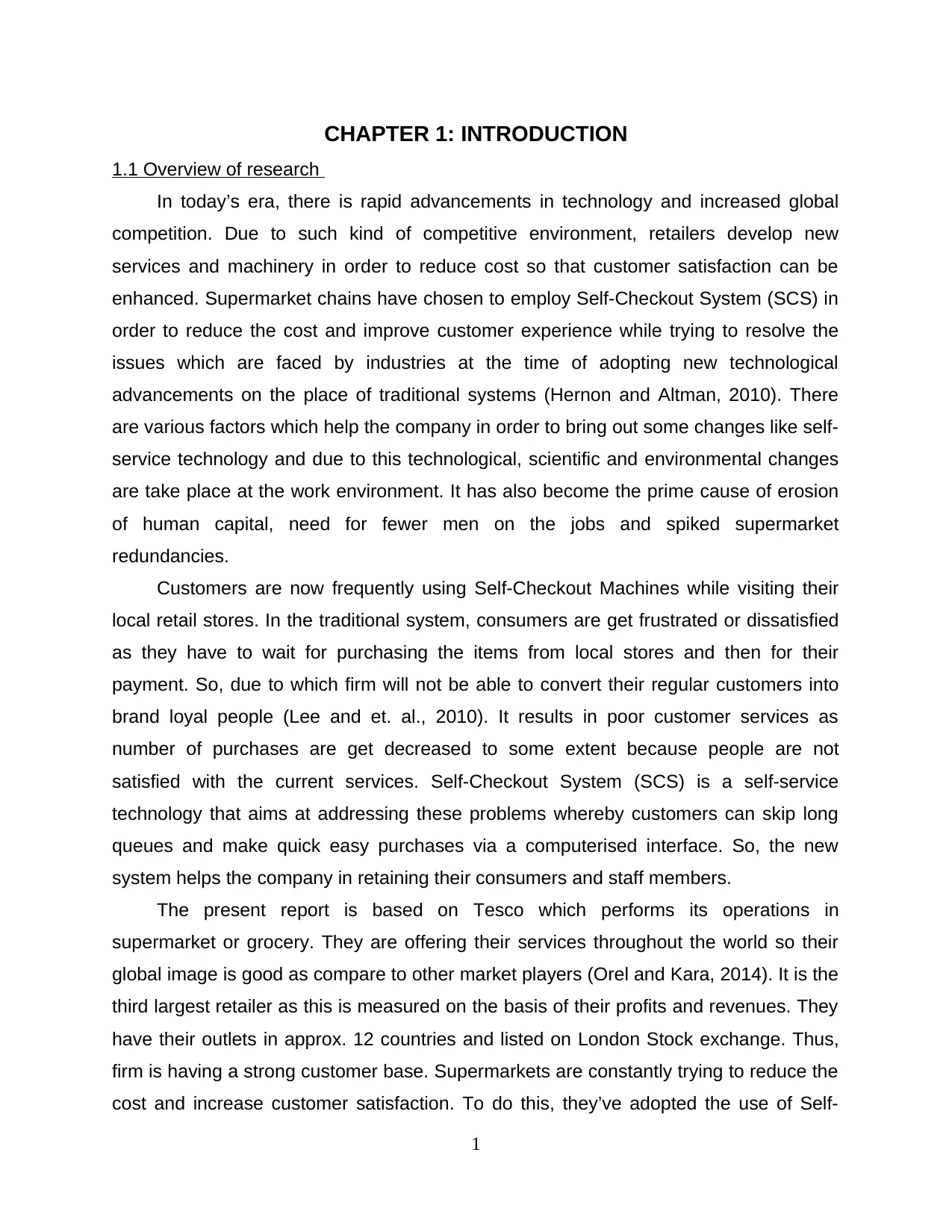
CHAPTER 1: INTRODUCTION
1.1 Overview of research
In today’s era, there is rapid advancements in technology and increased global
competition. Due to such kind of competitive environment, retailers develop new
services and machinery in order to reduce cost so that customer satisfaction can be
enhanced. Supermarket chains have chosen to employ Self-Checkout System (SCS) in
order to reduce the cost and improve customer experience while trying to resolve the
issues which are faced by industries at the time of adopting new technological
advancements on the place of traditional systems (Hernon and Altman, 2010). There
are various factors which help the company in order to bring out some changes like self-
service technology and due to this technological, scientific and environmental changes
are take place at the work environment. It has also become the prime cause of erosion
of human capital, need for fewer men on the jobs and spiked supermarket
redundancies.
Customers are now frequently using Self-Checkout Machines while visiting their
local retail stores. In the traditional system, consumers are get frustrated or dissatisfied
as they have to wait for purchasing the items from local stores and then for their
payment. So, due to which firm will not be able to convert their regular customers into
brand loyal people (Lee and et. al., 2010). It results in poor customer services as
number of purchases are get decreased to some extent because people are not
satisfied with the current services. Self-Checkout System (SCS) is a self-service
technology that aims at addressing these problems whereby customers can skip long
queues and make quick easy purchases via a computerised interface. So, the new
system helps the company in retaining their consumers and staff members.
The present report is based on Tesco which performs its operations in
supermarket or grocery. They are offering their services throughout the world so their
global image is good as compare to other market players (Orel and Kara, 2014). It is the
third largest retailer as this is measured on the basis of their profits and revenues. They
have their outlets in approx. 12 countries and listed on London Stock exchange. Thus,
firm is having a strong customer base. Supermarkets are constantly trying to reduce the
cost and increase customer satisfaction. To do this, they’ve adopted the use of Self-
1
1.1 Overview of research
In today’s era, there is rapid advancements in technology and increased global
competition. Due to such kind of competitive environment, retailers develop new
services and machinery in order to reduce cost so that customer satisfaction can be
enhanced. Supermarket chains have chosen to employ Self-Checkout System (SCS) in
order to reduce the cost and improve customer experience while trying to resolve the
issues which are faced by industries at the time of adopting new technological
advancements on the place of traditional systems (Hernon and Altman, 2010). There
are various factors which help the company in order to bring out some changes like self-
service technology and due to this technological, scientific and environmental changes
are take place at the work environment. It has also become the prime cause of erosion
of human capital, need for fewer men on the jobs and spiked supermarket
redundancies.
Customers are now frequently using Self-Checkout Machines while visiting their
local retail stores. In the traditional system, consumers are get frustrated or dissatisfied
as they have to wait for purchasing the items from local stores and then for their
payment. So, due to which firm will not be able to convert their regular customers into
brand loyal people (Lee and et. al., 2010). It results in poor customer services as
number of purchases are get decreased to some extent because people are not
satisfied with the current services. Self-Checkout System (SCS) is a self-service
technology that aims at addressing these problems whereby customers can skip long
queues and make quick easy purchases via a computerised interface. So, the new
system helps the company in retaining their consumers and staff members.
The present report is based on Tesco which performs its operations in
supermarket or grocery. They are offering their services throughout the world so their
global image is good as compare to other market players (Orel and Kara, 2014). It is the
third largest retailer as this is measured on the basis of their profits and revenues. They
have their outlets in approx. 12 countries and listed on London Stock exchange. Thus,
firm is having a strong customer base. Supermarkets are constantly trying to reduce the
cost and increase customer satisfaction. To do this, they’ve adopted the use of Self-
1
⊘ This is a preview!⊘
Do you want full access?
Subscribe today to unlock all pages.

Trusted by 1+ million students worldwide
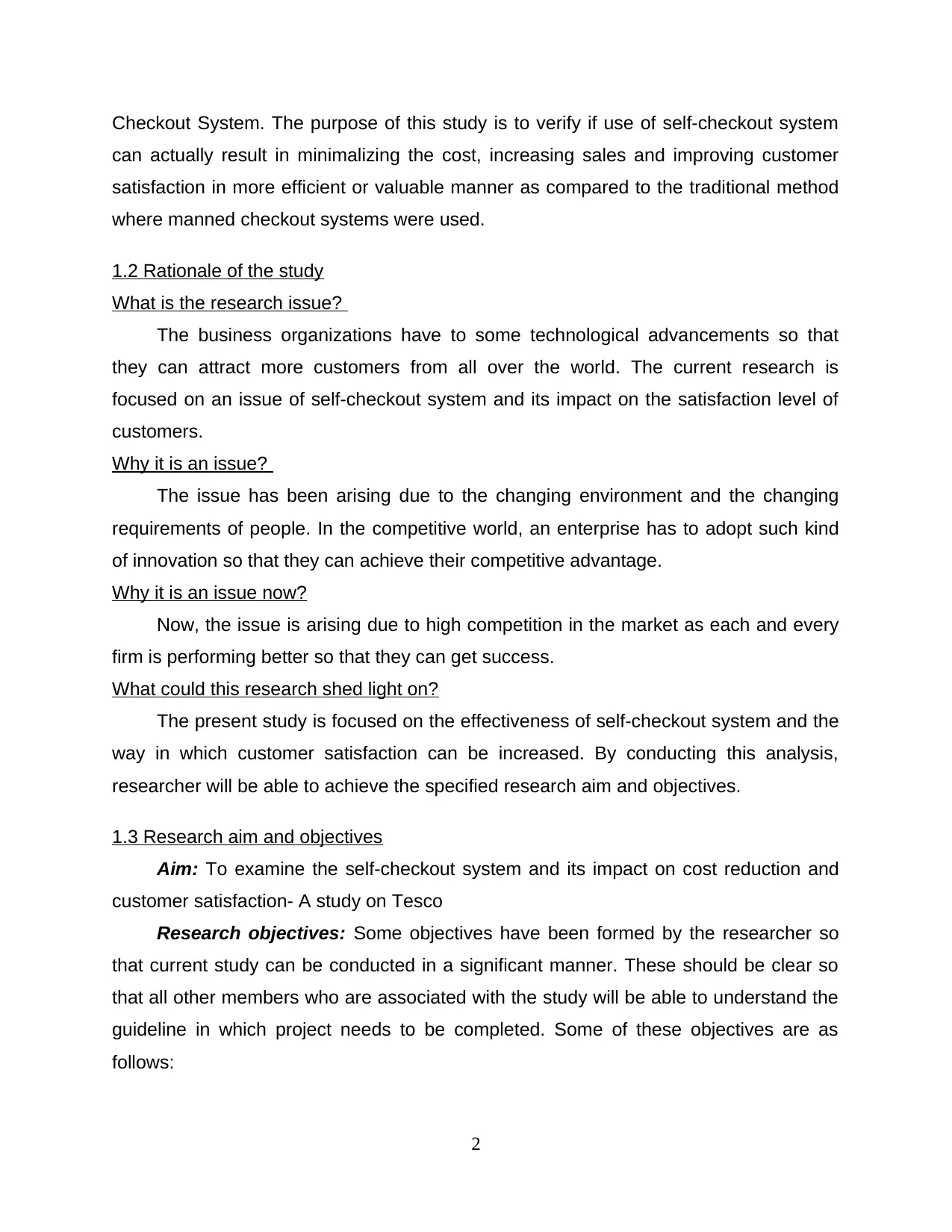
Checkout System. The purpose of this study is to verify if use of self-checkout system
can actually result in minimalizing the cost, increasing sales and improving customer
satisfaction in more efficient or valuable manner as compared to the traditional method
where manned checkout systems were used.
1.2 Rationale of the study
What is the research issue?
The business organizations have to some technological advancements so that
they can attract more customers from all over the world. The current research is
focused on an issue of self-checkout system and its impact on the satisfaction level of
customers.
Why it is an issue?
The issue has been arising due to the changing environment and the changing
requirements of people. In the competitive world, an enterprise has to adopt such kind
of innovation so that they can achieve their competitive advantage.
Why it is an issue now?
Now, the issue is arising due to high competition in the market as each and every
firm is performing better so that they can get success.
What could this research shed light on?
The present study is focused on the effectiveness of self-checkout system and the
way in which customer satisfaction can be increased. By conducting this analysis,
researcher will be able to achieve the specified research aim and objectives.
1.3 Research aim and objectives
Aim: To examine the self-checkout system and its impact on cost reduction and
customer satisfaction- A study on Tesco
Research objectives: Some objectives have been formed by the researcher so
that current study can be conducted in a significant manner. These should be clear so
that all other members who are associated with the study will be able to understand the
guideline in which project needs to be completed. Some of these objectives are as
follows:
2
can actually result in minimalizing the cost, increasing sales and improving customer
satisfaction in more efficient or valuable manner as compared to the traditional method
where manned checkout systems were used.
1.2 Rationale of the study
What is the research issue?
The business organizations have to some technological advancements so that
they can attract more customers from all over the world. The current research is
focused on an issue of self-checkout system and its impact on the satisfaction level of
customers.
Why it is an issue?
The issue has been arising due to the changing environment and the changing
requirements of people. In the competitive world, an enterprise has to adopt such kind
of innovation so that they can achieve their competitive advantage.
Why it is an issue now?
Now, the issue is arising due to high competition in the market as each and every
firm is performing better so that they can get success.
What could this research shed light on?
The present study is focused on the effectiveness of self-checkout system and the
way in which customer satisfaction can be increased. By conducting this analysis,
researcher will be able to achieve the specified research aim and objectives.
1.3 Research aim and objectives
Aim: To examine the self-checkout system and its impact on cost reduction and
customer satisfaction- A study on Tesco
Research objectives: Some objectives have been formed by the researcher so
that current study can be conducted in a significant manner. These should be clear so
that all other members who are associated with the study will be able to understand the
guideline in which project needs to be completed. Some of these objectives are as
follows:
2
Paraphrase This Document
Need a fresh take? Get an instant paraphrase of this document with our AI Paraphraser
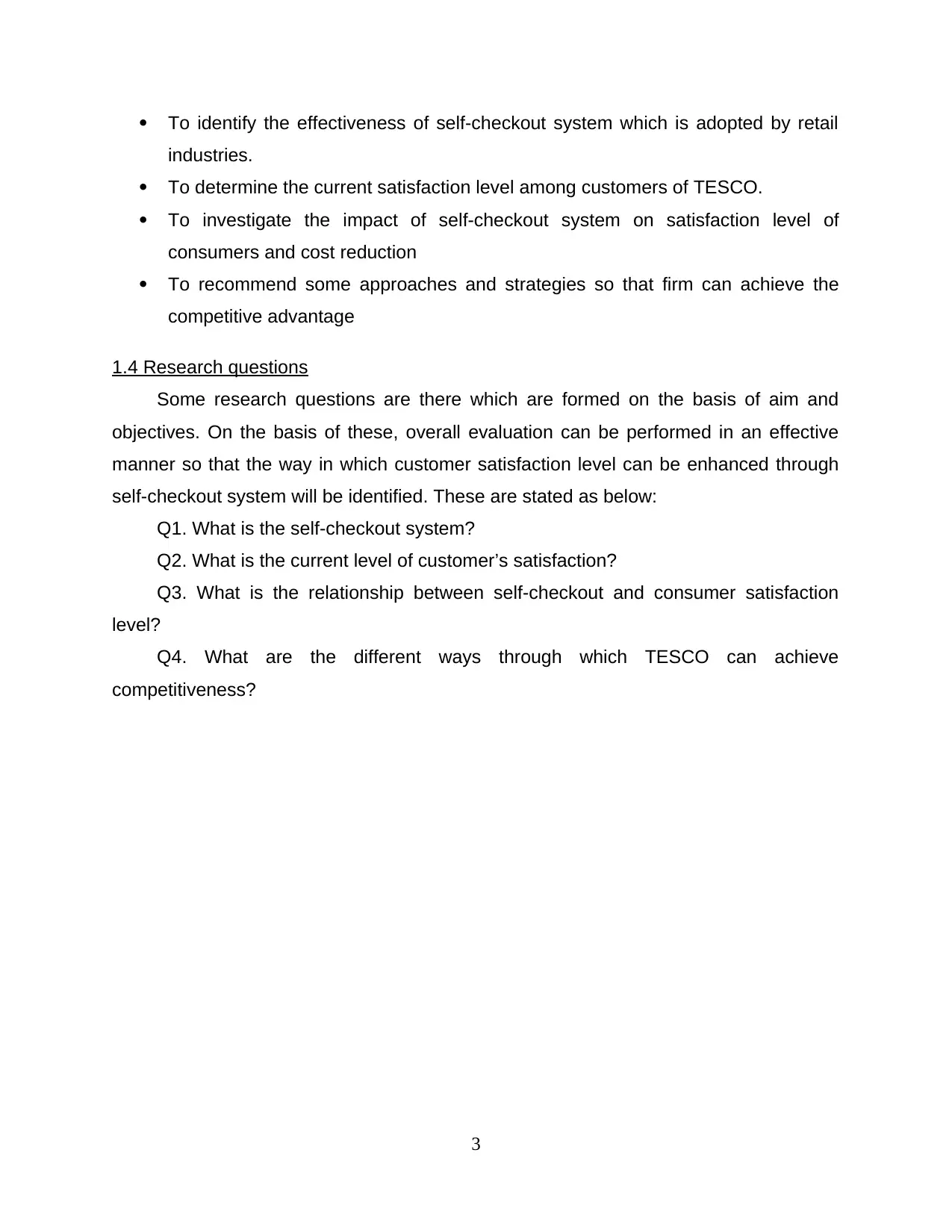
To identify the effectiveness of self-checkout system which is adopted by retail
industries.
To determine the current satisfaction level among customers of TESCO.
To investigate the impact of self-checkout system on satisfaction level of
consumers and cost reduction
To recommend some approaches and strategies so that firm can achieve the
competitive advantage
1.4 Research questions
Some research questions are there which are formed on the basis of aim and
objectives. On the basis of these, overall evaluation can be performed in an effective
manner so that the way in which customer satisfaction level can be enhanced through
self-checkout system will be identified. These are stated as below:
Q1. What is the self-checkout system?
Q2. What is the current level of customer’s satisfaction?
Q3. What is the relationship between self-checkout and consumer satisfaction
level?
Q4. What are the different ways through which TESCO can achieve
competitiveness?
3
industries.
To determine the current satisfaction level among customers of TESCO.
To investigate the impact of self-checkout system on satisfaction level of
consumers and cost reduction
To recommend some approaches and strategies so that firm can achieve the
competitive advantage
1.4 Research questions
Some research questions are there which are formed on the basis of aim and
objectives. On the basis of these, overall evaluation can be performed in an effective
manner so that the way in which customer satisfaction level can be enhanced through
self-checkout system will be identified. These are stated as below:
Q1. What is the self-checkout system?
Q2. What is the current level of customer’s satisfaction?
Q3. What is the relationship between self-checkout and consumer satisfaction
level?
Q4. What are the different ways through which TESCO can achieve
competitiveness?
3
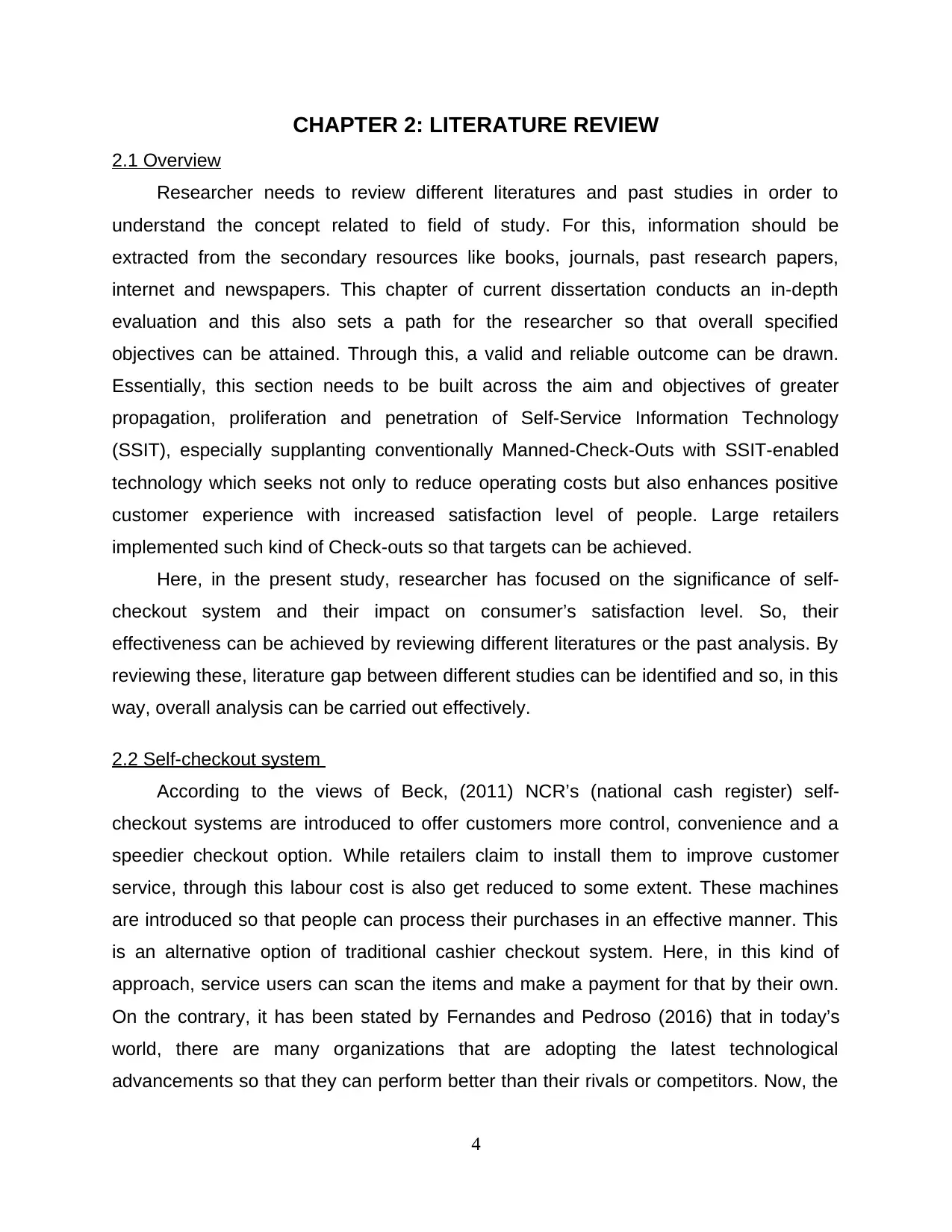
CHAPTER 2: LITERATURE REVIEW
2.1 Overview
Researcher needs to review different literatures and past studies in order to
understand the concept related to field of study. For this, information should be
extracted from the secondary resources like books, journals, past research papers,
internet and newspapers. This chapter of current dissertation conducts an in-depth
evaluation and this also sets a path for the researcher so that overall specified
objectives can be attained. Through this, a valid and reliable outcome can be drawn.
Essentially, this section needs to be built across the aim and objectives of greater
propagation, proliferation and penetration of Self-Service Information Technology
(SSIT), especially supplanting conventionally Manned-Check-Outs with SSIT-enabled
technology which seeks not only to reduce operating costs but also enhances positive
customer experience with increased satisfaction level of people. Large retailers
implemented such kind of Check-outs so that targets can be achieved.
Here, in the present study, researcher has focused on the significance of self-
checkout system and their impact on consumer’s satisfaction level. So, their
effectiveness can be achieved by reviewing different literatures or the past analysis. By
reviewing these, literature gap between different studies can be identified and so, in this
way, overall analysis can be carried out effectively.
2.2 Self-checkout system
According to the views of Beck, (2011) NCR’s (national cash register) self-
checkout systems are introduced to offer customers more control, convenience and a
speedier checkout option. While retailers claim to install them to improve customer
service, through this labour cost is also get reduced to some extent. These machines
are introduced so that people can process their purchases in an effective manner. This
is an alternative option of traditional cashier checkout system. Here, in this kind of
approach, service users can scan the items and make a payment for that by their own.
On the contrary, it has been stated by Fernandes and Pedroso (2016) that in today’s
world, there are many organizations that are adopting the latest technological
advancements so that they can perform better than their rivals or competitors. Now, the
4
2.1 Overview
Researcher needs to review different literatures and past studies in order to
understand the concept related to field of study. For this, information should be
extracted from the secondary resources like books, journals, past research papers,
internet and newspapers. This chapter of current dissertation conducts an in-depth
evaluation and this also sets a path for the researcher so that overall specified
objectives can be attained. Through this, a valid and reliable outcome can be drawn.
Essentially, this section needs to be built across the aim and objectives of greater
propagation, proliferation and penetration of Self-Service Information Technology
(SSIT), especially supplanting conventionally Manned-Check-Outs with SSIT-enabled
technology which seeks not only to reduce operating costs but also enhances positive
customer experience with increased satisfaction level of people. Large retailers
implemented such kind of Check-outs so that targets can be achieved.
Here, in the present study, researcher has focused on the significance of self-
checkout system and their impact on consumer’s satisfaction level. So, their
effectiveness can be achieved by reviewing different literatures or the past analysis. By
reviewing these, literature gap between different studies can be identified and so, in this
way, overall analysis can be carried out effectively.
2.2 Self-checkout system
According to the views of Beck, (2011) NCR’s (national cash register) self-
checkout systems are introduced to offer customers more control, convenience and a
speedier checkout option. While retailers claim to install them to improve customer
service, through this labour cost is also get reduced to some extent. These machines
are introduced so that people can process their purchases in an effective manner. This
is an alternative option of traditional cashier checkout system. Here, in this kind of
approach, service users can scan the items and make a payment for that by their own.
On the contrary, it has been stated by Fernandes and Pedroso (2016) that in today’s
world, there are many organizations that are adopting the latest technological
advancements so that they can perform better than their rivals or competitors. Now, the
4
⊘ This is a preview!⊘
Do you want full access?
Subscribe today to unlock all pages.

Trusted by 1+ million students worldwide
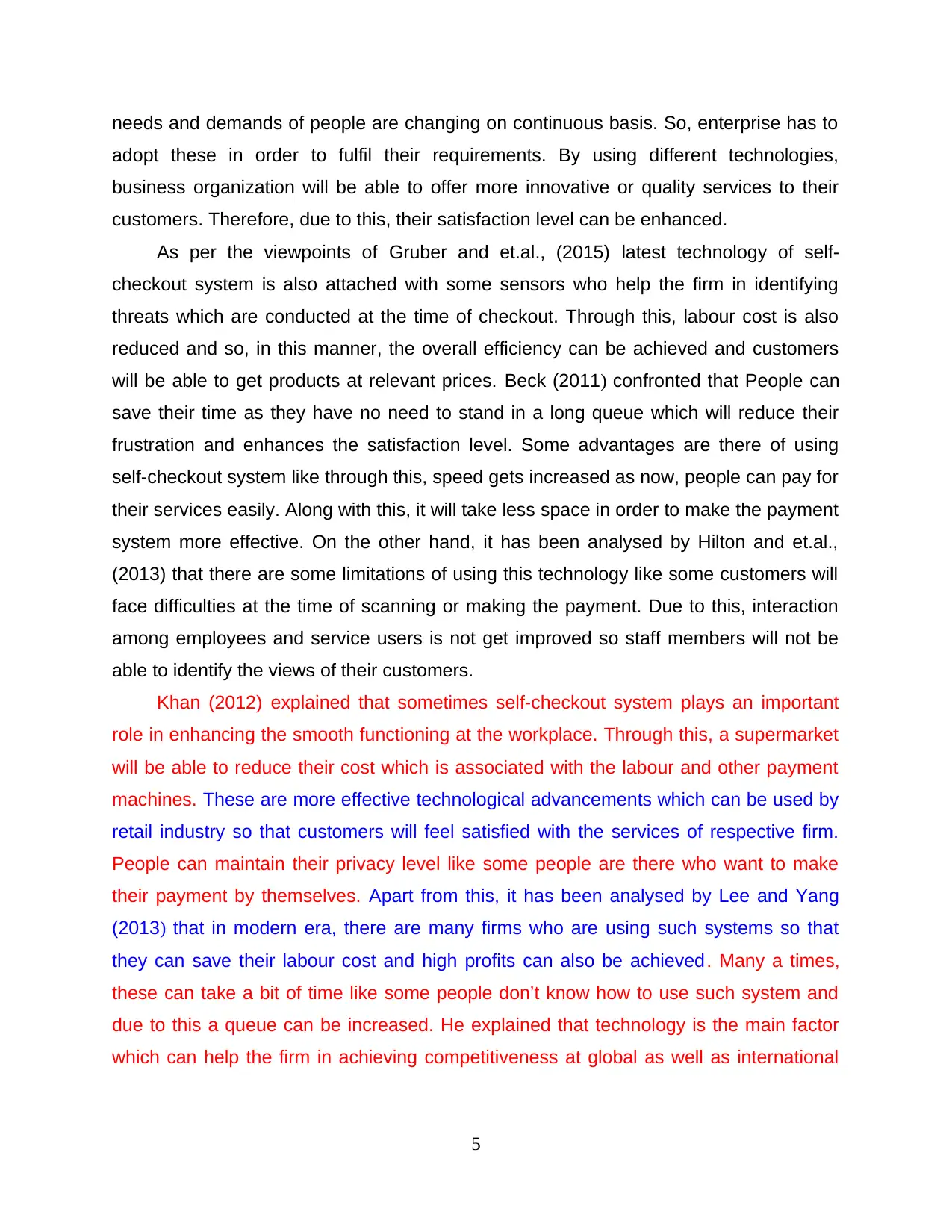
needs and demands of people are changing on continuous basis. So, enterprise has to
adopt these in order to fulfil their requirements. By using different technologies,
business organization will be able to offer more innovative or quality services to their
customers. Therefore, due to this, their satisfaction level can be enhanced.
As per the viewpoints of Gruber and et.al., (2015) latest technology of self-
checkout system is also attached with some sensors who help the firm in identifying
threats which are conducted at the time of checkout. Through this, labour cost is also
reduced and so, in this manner, the overall efficiency can be achieved and customers
will be able to get products at relevant prices. Beck (2011) confronted that People can
save their time as they have no need to stand in a long queue which will reduce their
frustration and enhances the satisfaction level. Some advantages are there of using
self-checkout system like through this, speed gets increased as now, people can pay for
their services easily. Along with this, it will take less space in order to make the payment
system more effective. On the other hand, it has been analysed by Hilton and et.al.,
(2013) that there are some limitations of using this technology like some customers will
face difficulties at the time of scanning or making the payment. Due to this, interaction
among employees and service users is not get improved so staff members will not be
able to identify the views of their customers.
Khan (2012) explained that sometimes self-checkout system plays an important
role in enhancing the smooth functioning at the workplace. Through this, a supermarket
will be able to reduce their cost which is associated with the labour and other payment
machines. These are more effective technological advancements which can be used by
retail industry so that customers will feel satisfied with the services of respective firm.
People can maintain their privacy level like some people are there who want to make
their payment by themselves. Apart from this, it has been analysed by Lee and Yang
(2013) that in modern era, there are many firms who are using such systems so that
they can save their labour cost and high profits can also be achieved. Many a times,
these can take a bit of time like some people don’t know how to use such system and
due to this a queue can be increased. He explained that technology is the main factor
which can help the firm in achieving competitiveness at global as well as international
5
adopt these in order to fulfil their requirements. By using different technologies,
business organization will be able to offer more innovative or quality services to their
customers. Therefore, due to this, their satisfaction level can be enhanced.
As per the viewpoints of Gruber and et.al., (2015) latest technology of self-
checkout system is also attached with some sensors who help the firm in identifying
threats which are conducted at the time of checkout. Through this, labour cost is also
reduced and so, in this manner, the overall efficiency can be achieved and customers
will be able to get products at relevant prices. Beck (2011) confronted that People can
save their time as they have no need to stand in a long queue which will reduce their
frustration and enhances the satisfaction level. Some advantages are there of using
self-checkout system like through this, speed gets increased as now, people can pay for
their services easily. Along with this, it will take less space in order to make the payment
system more effective. On the other hand, it has been analysed by Hilton and et.al.,
(2013) that there are some limitations of using this technology like some customers will
face difficulties at the time of scanning or making the payment. Due to this, interaction
among employees and service users is not get improved so staff members will not be
able to identify the views of their customers.
Khan (2012) explained that sometimes self-checkout system plays an important
role in enhancing the smooth functioning at the workplace. Through this, a supermarket
will be able to reduce their cost which is associated with the labour and other payment
machines. These are more effective technological advancements which can be used by
retail industry so that customers will feel satisfied with the services of respective firm.
People can maintain their privacy level like some people are there who want to make
their payment by themselves. Apart from this, it has been analysed by Lee and Yang
(2013) that in modern era, there are many firms who are using such systems so that
they can save their labour cost and high profits can also be achieved. Many a times,
these can take a bit of time like some people don’t know how to use such system and
due to this a queue can be increased. He explained that technology is the main factor
which can help the firm in achieving competitiveness at global as well as international
5
Paraphrase This Document
Need a fresh take? Get an instant paraphrase of this document with our AI Paraphraser
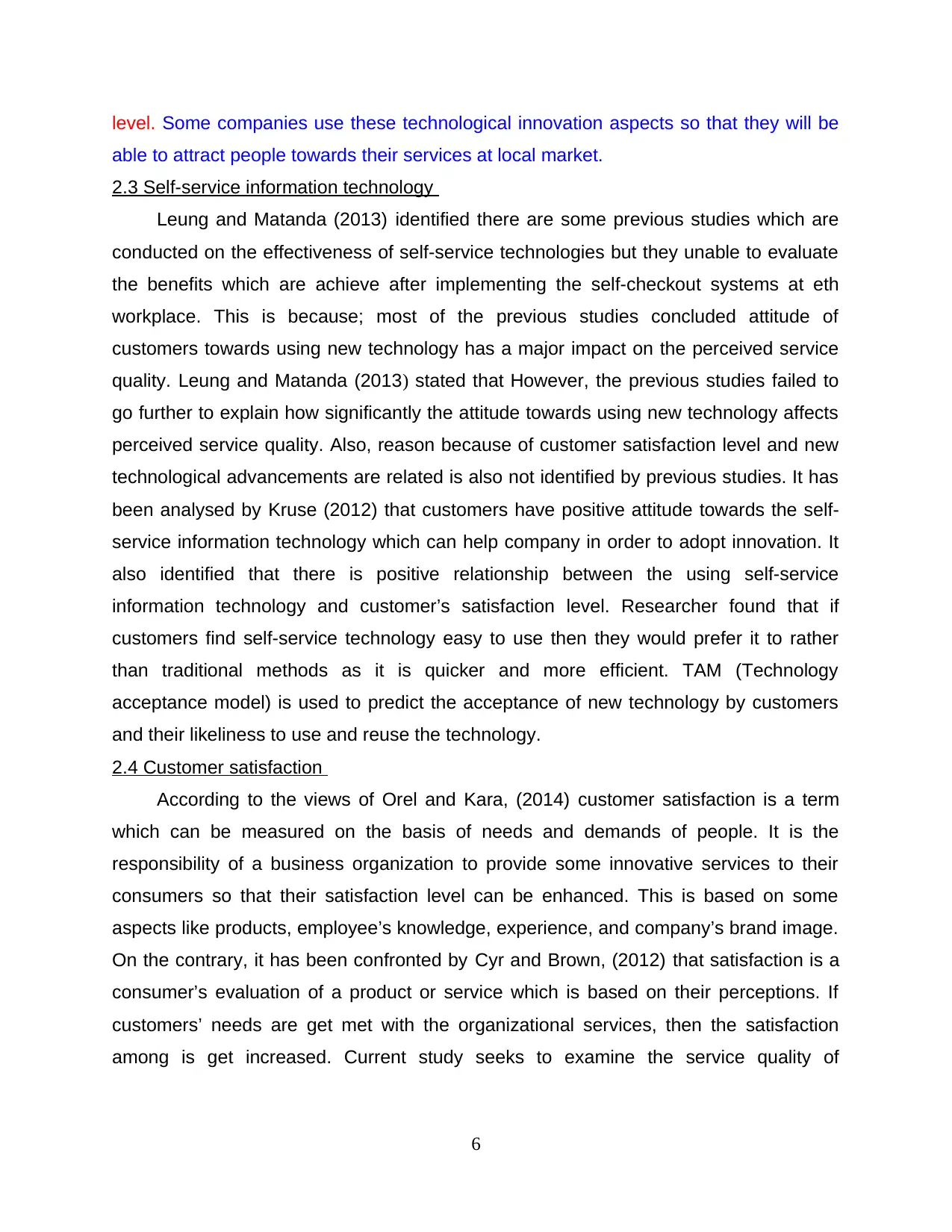
level. Some companies use these technological innovation aspects so that they will be
able to attract people towards their services at local market.
2.3 Self-service information technology
Leung and Matanda (2013) identified there are some previous studies which are
conducted on the effectiveness of self-service technologies but they unable to evaluate
the benefits which are achieve after implementing the self-checkout systems at eth
workplace. This is because; most of the previous studies concluded attitude of
customers towards using new technology has a major impact on the perceived service
quality. Leung and Matanda (2013) stated that However, the previous studies failed to
go further to explain how significantly the attitude towards using new technology affects
perceived service quality. Also, reason because of customer satisfaction level and new
technological advancements are related is also not identified by previous studies. It has
been analysed by Kruse (2012) that customers have positive attitude towards the self-
service information technology which can help company in order to adopt innovation. It
also identified that there is positive relationship between the using self-service
information technology and customer’s satisfaction level. Researcher found that if
customers find self-service technology easy to use then they would prefer it to rather
than traditional methods as it is quicker and more efficient. TAM (Technology
acceptance model) is used to predict the acceptance of new technology by customers
and their likeliness to use and reuse the technology.
2.4 Customer satisfaction
According to the views of Orel and Kara, (2014) customer satisfaction is a term
which can be measured on the basis of needs and demands of people. It is the
responsibility of a business organization to provide some innovative services to their
consumers so that their satisfaction level can be enhanced. This is based on some
aspects like products, employee’s knowledge, experience, and company’s brand image.
On the contrary, it has been confronted by Cyr and Brown, (2012) that satisfaction is a
consumer’s evaluation of a product or service which is based on their perceptions. If
customers’ needs are get met with the organizational services, then the satisfaction
among is get increased. Current study seeks to examine the service quality of
6
able to attract people towards their services at local market.
2.3 Self-service information technology
Leung and Matanda (2013) identified there are some previous studies which are
conducted on the effectiveness of self-service technologies but they unable to evaluate
the benefits which are achieve after implementing the self-checkout systems at eth
workplace. This is because; most of the previous studies concluded attitude of
customers towards using new technology has a major impact on the perceived service
quality. Leung and Matanda (2013) stated that However, the previous studies failed to
go further to explain how significantly the attitude towards using new technology affects
perceived service quality. Also, reason because of customer satisfaction level and new
technological advancements are related is also not identified by previous studies. It has
been analysed by Kruse (2012) that customers have positive attitude towards the self-
service information technology which can help company in order to adopt innovation. It
also identified that there is positive relationship between the using self-service
information technology and customer’s satisfaction level. Researcher found that if
customers find self-service technology easy to use then they would prefer it to rather
than traditional methods as it is quicker and more efficient. TAM (Technology
acceptance model) is used to predict the acceptance of new technology by customers
and their likeliness to use and reuse the technology.
2.4 Customer satisfaction
According to the views of Orel and Kara, (2014) customer satisfaction is a term
which can be measured on the basis of needs and demands of people. It is the
responsibility of a business organization to provide some innovative services to their
consumers so that their satisfaction level can be enhanced. This is based on some
aspects like products, employee’s knowledge, experience, and company’s brand image.
On the contrary, it has been confronted by Cyr and Brown, (2012) that satisfaction is a
consumer’s evaluation of a product or service which is based on their perceptions. If
customers’ needs are get met with the organizational services, then the satisfaction
among is get increased. Current study seeks to examine the service quality of
6
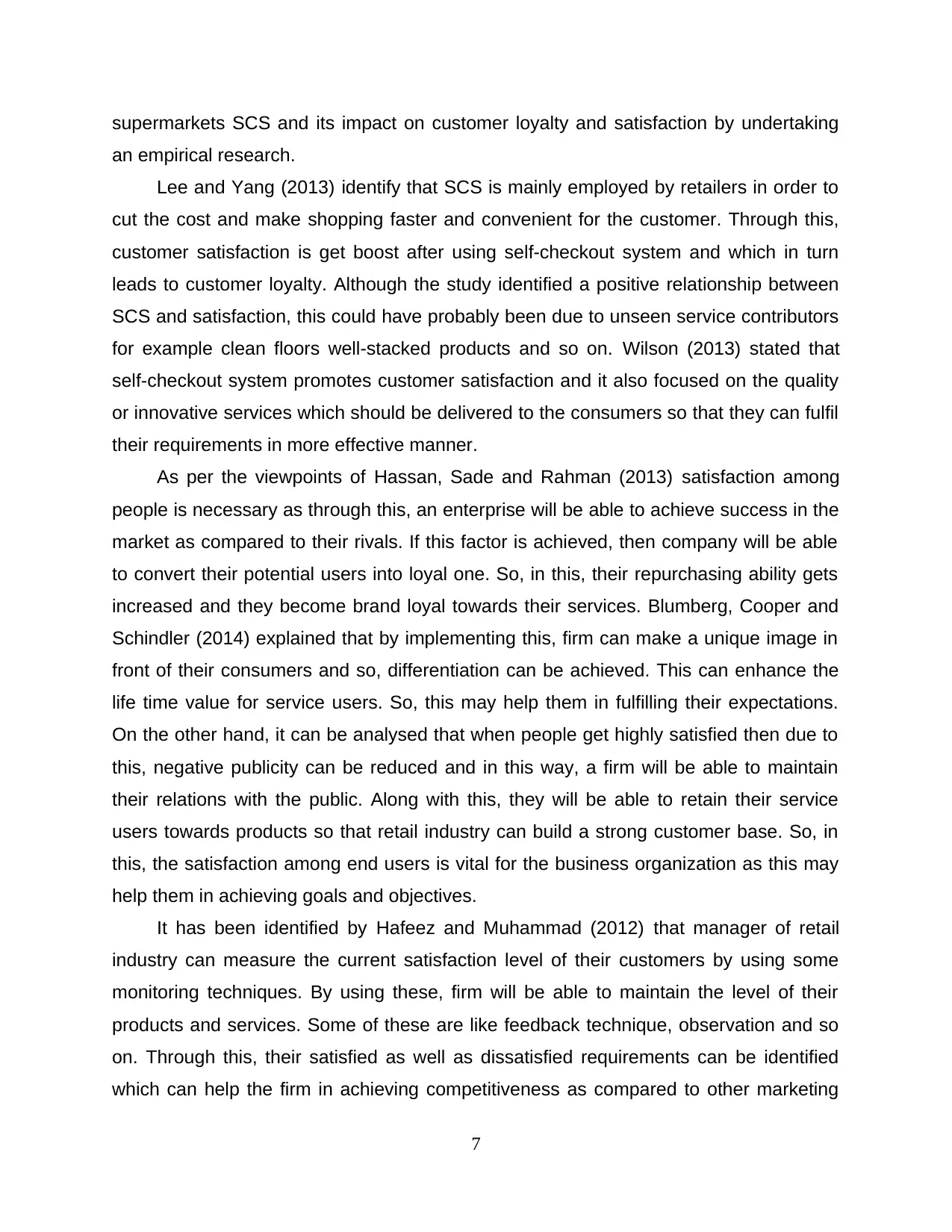
supermarkets SCS and its impact on customer loyalty and satisfaction by undertaking
an empirical research.
Lee and Yang (2013) identify that SCS is mainly employed by retailers in order to
cut the cost and make shopping faster and convenient for the customer. Through this,
customer satisfaction is get boost after using self-checkout system and which in turn
leads to customer loyalty. Although the study identified a positive relationship between
SCS and satisfaction, this could have probably been due to unseen service contributors
for example clean floors well-stacked products and so on. Wilson (2013) stated that
self-checkout system promotes customer satisfaction and it also focused on the quality
or innovative services which should be delivered to the consumers so that they can fulfil
their requirements in more effective manner.
As per the viewpoints of Hassan, Sade and Rahman (2013) satisfaction among
people is necessary as through this, an enterprise will be able to achieve success in the
market as compared to their rivals. If this factor is achieved, then company will be able
to convert their potential users into loyal one. So, in this, their repurchasing ability gets
increased and they become brand loyal towards their services. Blumberg, Cooper and
Schindler (2014) explained that by implementing this, firm can make a unique image in
front of their consumers and so, differentiation can be achieved. This can enhance the
life time value for service users. So, this may help them in fulfilling their expectations.
On the other hand, it can be analysed that when people get highly satisfied then due to
this, negative publicity can be reduced and in this way, a firm will be able to maintain
their relations with the public. Along with this, they will be able to retain their service
users towards products so that retail industry can build a strong customer base. So, in
this, the satisfaction among end users is vital for the business organization as this may
help them in achieving goals and objectives.
It has been identified by Hafeez and Muhammad (2012) that manager of retail
industry can measure the current satisfaction level of their customers by using some
monitoring techniques. By using these, firm will be able to maintain the level of their
products and services. Some of these are like feedback technique, observation and so
on. Through this, their satisfied as well as dissatisfied requirements can be identified
which can help the firm in achieving competitiveness as compared to other marketing
7
an empirical research.
Lee and Yang (2013) identify that SCS is mainly employed by retailers in order to
cut the cost and make shopping faster and convenient for the customer. Through this,
customer satisfaction is get boost after using self-checkout system and which in turn
leads to customer loyalty. Although the study identified a positive relationship between
SCS and satisfaction, this could have probably been due to unseen service contributors
for example clean floors well-stacked products and so on. Wilson (2013) stated that
self-checkout system promotes customer satisfaction and it also focused on the quality
or innovative services which should be delivered to the consumers so that they can fulfil
their requirements in more effective manner.
As per the viewpoints of Hassan, Sade and Rahman (2013) satisfaction among
people is necessary as through this, an enterprise will be able to achieve success in the
market as compared to their rivals. If this factor is achieved, then company will be able
to convert their potential users into loyal one. So, in this, their repurchasing ability gets
increased and they become brand loyal towards their services. Blumberg, Cooper and
Schindler (2014) explained that by implementing this, firm can make a unique image in
front of their consumers and so, differentiation can be achieved. This can enhance the
life time value for service users. So, this may help them in fulfilling their expectations.
On the other hand, it can be analysed that when people get highly satisfied then due to
this, negative publicity can be reduced and in this way, a firm will be able to maintain
their relations with the public. Along with this, they will be able to retain their service
users towards products so that retail industry can build a strong customer base. So, in
this, the satisfaction among end users is vital for the business organization as this may
help them in achieving goals and objectives.
It has been identified by Hafeez and Muhammad (2012) that manager of retail
industry can measure the current satisfaction level of their customers by using some
monitoring techniques. By using these, firm will be able to maintain the level of their
products and services. Some of these are like feedback technique, observation and so
on. Through this, their satisfied as well as dissatisfied requirements can be identified
which can help the firm in achieving competitiveness as compared to other marketing
7
⊘ This is a preview!⊘
Do you want full access?
Subscribe today to unlock all pages.

Trusted by 1+ million students worldwide
1 out of 46
Related Documents
Your All-in-One AI-Powered Toolkit for Academic Success.
+13062052269
info@desklib.com
Available 24*7 on WhatsApp / Email
![[object Object]](/_next/static/media/star-bottom.7253800d.svg)
Unlock your academic potential
Copyright © 2020–2025 A2Z Services. All Rights Reserved. Developed and managed by ZUCOL.



